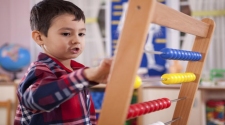Children are more prone to skin sensitivity than adults, as their immune systems are still developing. There can be many more environmental factors that may cause the skin to be irritated. While children often outgrow allergies and adverse reactions, anything from air fresheners to dietary habits, sunshine to aerosol sprays, can still make life difficult for children with sensitive skin. It’s important to both root out the causes and prevent further problems wherever possible. Here is a guide to tackling the typical culprits.

Household Cleaning
In terms of general household cleaning, try to minimise your use of air fresheners and wood polish while your kids are at home, as breathing problems like asthma – often experienced in tandem with skin allergies – can be aggravated by aerosols. Harsh household cleaners containing bleach are also best-avoided where possible.
Look out for pH-neutral detergents and fabric softeners that don’t contain living enzymes, particularly those specially-designed with kids in mind. There is good news on this score, as plenty of non-biological detergents now exist, like Surf Excel Gentle Wash.
What they’re Wearing
Kids love receiving new clothes or bed sheets as gifts, but they are often still coated in factory starching chemicals that may provoke a reaction if used straight out of the store. Put new linens through the washing machine first to get rid of this possible source of irritation.
In general, try to pick breathable, light fabrics for your children’s clothing. Natural fibres like cotton and silk are good options – organically produced if you can find them – but watch out for wool next to your child’s skin as this can cause itching.
Personal Skincare
Though children should learn to routinely wash hands and faces after playing outdoors or getting messy – as they love to do – those with sensitive skin shouldn’t use soap too often. Try fragrance-free soap, mild cleansers, or aqueous cream to avoid drying out skin. When it comes to bath time, shower gels and bath oils with high-moisture contents are best.
Children with sensitive skin are also more likely to be greater risk of the sun, so invest in a high-factor sun-block for the summer months. Sweat-proof and water-resistant brands are good for kids that lead action-packed lives in the holidays, but always look for a sensitive-skin option to avoid irritation from chemical additives. Buy your child a sun-hat, and keep them covered up as much as is comfortable, especially during the middle of the day. Be aware that extreme heat variations can cause irritable skin to flare up.
Treating the Symptoms
Signs of sensitivity range from a slight redness and tendency towards rashes or blotching, to dry, flaky skin of a thin, sometimes with a translucent texture. If your child does develop mildly irritated skin, there are lots of simple ways to tackle the problem. In the first instance, try cooling down the area. An over-the-counter cooling lotion containing menthol may help. This can also be a handy product to keep in the medicine cabinet – or the fridge – for general heat rash.
If reactions persist or spread, it’s best to pay a visit your doctor or a dermatologist (a skin specialist). Those diagnosed with eczema or similar conditions will be prescribed special cleaning products and daily creams or ointments. Severe reactions that feature blistering, leaking fluid, or scabbing always warrant medical advice.
Of course, it’s impossible to keep a completely irritant-free household and kids can develop allergies from unknown sources as well, so don’t feel the responsibility is entirely on your shoulders. Though moms often want to protect their children from everything life throws at them, this just isn’t always possible – nor is it always healthy for your child. Sensitive skin can’t always be cured or prevented, but by following a few basic rules and avoiding certain products, you can limit the impact sensitive skin has on your child’s life.















